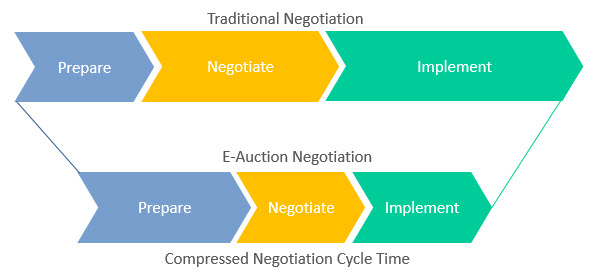e-Auctions don’t only focus on price
e-Sourcing Facts: The Truth about e-Auctions: In part 1 we discussed the counter argument to the perception that e-Auctions damage supplier relationships.
Here in part 2 we counter the argument to the perception that e-Auctions only focus on price
1. Preparation for success
This common misconception is created by only considering the final negotiation at the end of the sourcing process. In fact, most of the work is up front, with the auction only taking up a small fraction of the whole process time. Therefore, the traditional skills of developing RFI’s & RFQ’s is essential to setting up an e-Auction – which sets the same requirements electronically. Best practice dictates that time and resource must be spent:
- Making sure the specifications are correct and clearly defined
- Expected service levels are correct and clearly defined
- Only suppliers who can meet those requirements and have a real chance of winning are invited to participate.
So even though the final Event looks at price, 90% of the process is geared towards making sure all the other prerequisites are correct, so everyone involved is quoting like for like.
2. e-Auctions lock procurement professionals into price at the expense of value:
The suggestion that reverse auctions are only about price, also suggest that they drive down the suppliers margin to unsustainable levels and that they overshadow other important performance characteristics. In reality, they empower buyers on all kinds of parameters, such as, conditions, and specifications and also involve a face-to-face meeting after the Event with the leading participants.
3. Benefits of e-Auctions
eAuctions can provide significant benefits to businesses ranging from lower costs to creating a more transparent process:
3.1 Benefits to Buyers
- Allow buyers to set requirements electronically.
- Buyers can negotiate with any number of suppliers simultaneously, rather than sequentially, representing a significant saving in time.
- The full force of competition facilitates lower costs – in part due to the transparency of the sourcing process and competitors pricing.
3.2 Benefits to Suppliers
So, if suppliers have plenty to lose from participating in an e-Auction, do they have anything to gain? The answer is an emphatic yes!
- Suppliers can electronically respond to an e-RFP with online proposals detailing specifics such as delivery dates, shipment methods and price advantages and include attachments, ranging from certification documents to product drawings and specifications.
- e-Auctions make more efficient use of sales resources because suppliers don’t waste their time engaging in multi-round proposal processes.
- e-Auction solutions level the playing field, enabling small suppliers to compete for business on equal terms to large organizations.
4. e-Sourcing Facts: The Truth about e-Auctions
Everybody wins
 Although typically buyer-centric, e-Auction technology has proven to improve negotiations. By providing high levels of transparency to internal stakeholders and suppliers while also expediting the purchasing process they help build trust and substantially compress sourcing lead times. Something in my experience a CPO is always under pressure to achieve.
Although typically buyer-centric, e-Auction technology has proven to improve negotiations. By providing high levels of transparency to internal stakeholders and suppliers while also expediting the purchasing process they help build trust and substantially compress sourcing lead times. Something in my experience a CPO is always under pressure to achieve.
Early on in this post we said that the traditional skills of developing RFI’s & RFQ’s is essential to setting up an e-Auction:
- Defining requirements clearly
- Knowing your market
- Ensure a level playing field and
- Engaging with suppliers.
The technology involved is just a small element of this. The key is knowing when and where to employ it.
Nuff said …
You can read part 1 here
Contact us to learn more about our e-Sourcing products



